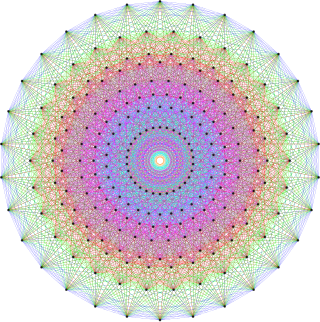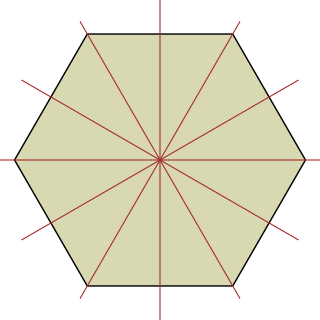In mathematics, particularly in algebra, a field extension is a pair of fields , such that the operations of K are those of L restricted to K. In this case, L is an extension field of K and K is a subfield of L. For example, under the usual notions of addition and multiplication, the complex numbers are an extension field of the real numbers; the real numbers are a subfield of the complex numbers.

In mathematics, a Lie algebra is a vector space together with an operation called the Lie bracket, an alternating bilinear map , that satisfies the Jacobi identity. In other words, a Lie algebra is an algebra over a field for which the multiplication operation is alternating and satisfies the Jacobi identity. The Lie bracket of two vectors and is denoted . A Lie algebra is typically a non-associative algebra. However, every associative algebra gives rise to a Lie algebra, consisting of the same vector space with the commutator Lie bracket, .
In mathematics, a profinite group is a topological group that is in a certain sense assembled from a system of finite groups.
In mathematics, a product is the result of multiplication, or an expression that identifies objects to be multiplied, called factors. For example, 21 is the product of 3 and 7, and is the product of and . When one factor is an integer, the product is called a multiple.
In mathematics, an abelian category is a category in which morphisms and objects can be added and in which kernels and cokernels exist and have desirable properties.
In mathematics, rings are algebraic structures that generalize fields: multiplication need not be commutative and multiplicative inverses need not exist. Informally, a ring is a set equipped with two binary operations satisfying properties analogous to those of addition and multiplication of integers. Ring elements may be numbers such as integers or complex numbers, but they may also be non-numerical objects such as polynomials, square matrices, functions, and power series.
In mathematics, a Hopf algebra, named after Heinz Hopf, is a structure that is simultaneously an algebra and a coalgebra, with these structures' compatibility making it a bialgebra, and that moreover is equipped with an antihomomorphism satisfying a certain property. The representation theory of a Hopf algebra is particularly nice, since the existence of compatible comultiplication, counit, and antipode allows for the construction of tensor products of representations, trivial representations, and dual representations.
In mathematics, a monoidal category is a category equipped with a bifunctor
In abstract algebra, a branch of mathematics, a simple ring is a non-zero ring that has no two-sided ideal besides the zero ideal and itself. In particular, a commutative ring is a simple ring if and only if it is a field.
In mathematics, especially in the area of abstract algebra known as module theory, an injective module is a module Q that shares certain desirable properties with the Z-module Q of all rational numbers. Specifically, if Q is a submodule of some other module, then it is already a direct summand of that module; also, given a submodule of a module Y, any module homomorphism from this submodule to Q can be extended to a homomorphism from all of Y to Q. This concept is dual to that of projective modules. Injective modules were introduced in and are discussed in some detail in the textbook.
In mathematics, especially in the fields of representation theory and module theory, a Frobenius algebra is a finite-dimensional unital associative algebra with a special kind of bilinear form which gives the algebras particularly nice duality theories. Frobenius algebras began to be studied in the 1930s by Richard Brauer and Cecil Nesbitt and were named after Georg Frobenius. Tadashi Nakayama discovered the beginnings of a rich duality theory, . Jean Dieudonné used this to characterize Frobenius algebras. Frobenius algebras were generalized to quasi-Frobenius rings, those Noetherian rings whose right regular representation is injective. In recent times, interest has been renewed in Frobenius algebras due to connections to topological quantum field theory.
In mathematics, an operad is a structure that consists of abstract operations, each one having a fixed finite number of inputs (arguments) and one output, as well as a specification of how to compose these operations. Given an operad , one defines an algebra over to be a set together with concrete operations on this set which behave just like the abstract operations of . For instance, there is a Lie operad such that the algebras over are precisely the Lie algebras; in a sense abstractly encodes the operations that are common to all Lie algebras. An operad is to its algebras as a group is to its group representations.
In category theory, a branch of mathematics, a dual object is an analogue of a dual vector space from linear algebra for objects in arbitrary monoidal categories. It is only a partial generalization, based upon the categorical properties of duality for finite-dimensional vector spaces. An object admitting a dual is called a dualizable object. In this formalism, infinite-dimensional vector spaces are not dualizable, since the dual vector space V∗ doesn't satisfy the axioms. Often, an object is dualizable only when it satisfies some finiteness or compactness property.
In abstract algebra, cohomological dimension is an invariant of a group which measures the homological complexity of its representations. It has important applications in geometric group theory, topology, and algebraic number theory.
In mathematics, the field with one element is a suggestive name for an object that should behave similarly to a finite field with a single element, if such a field could exist. This object is denoted F1, or, in a French–English pun, Fun. The name "field with one element" and the notation F1 are only suggestive, as there is no field with one element in classical abstract algebra. Instead, F1 refers to the idea that there should be a way to replace sets and operations, the traditional building blocks for abstract algebra, with other, more flexible objects. Many theories of F1 have been proposed, but it is not clear which, if any, of them give F1 all the desired properties. While there is still no field with a single element in these theories, there is a field-like object whose characteristic is one.
Schur–Weyl duality is a mathematical theorem in representation theory that relates irreducible finite-dimensional representations of the general linear and symmetric groups. It is named after two pioneers of representation theory of Lie groups, Issai Schur, who discovered the phenomenon, and Hermann Weyl, who popularized it in his books on quantum mechanics and classical groups as a way of classifying representations of unitary and general linear groups.

Representation theory is a branch of mathematics that studies abstract algebraic structures by representing their elements as linear transformations of vector spaces, and studies modules over these abstract algebraic structures. In essence, a representation makes an abstract algebraic object more concrete by describing its elements by matrices and their algebraic operations. The theory of matrices and linear operators is well-understood, so representations of more abstract objects in terms of familiar linear algebra objects help glean properties and sometimes simplify calculations on more abstract theories.
In mathematics, weak bialgebras are a generalization of bialgebras that are both algebras and coalgebras but for which the compatibility conditions between the two structures have been "weakened". In the same spirit, weak Hopf algebras are weak bialgebras together with a linear map S satisfying specific conditions; they are generalizations of Hopf algebras.
In mathematics, semi-simplicity is a widespread concept in disciplines such as linear algebra, abstract algebra, representation theory, category theory, and algebraic geometry. A semi-simple object is one that can be decomposed into a sum of simple objects, and simple objects are those that do not contain non-trivial proper sub-objects. The precise definitions of these words depends on the context.
In mathematics, compact objects, also referred to as finitely presented objects, or objects of finite presentation, are objects in a category satisfying a certain finiteness condition.






